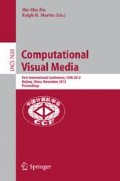Abstract
This paper describes a novel algorithm for image segmentation within the framework of evolutionary game theory. Beyond the pairwise model, our objective function enables exploration on larger patches by introducing clique probability, and enforcing pixels within clique be assigned the same label. By combining the Public Goods Game, our algorithm can efficiently solve the multi-label segmentation problem. Experiments on challenging datasets demonstrate that our algorithm outperforms the state-of-art. We believe that this algorithm can be extended to many other labeling problems.
Access this chapter
Tax calculation will be finalised at checkout
Purchases are for personal use only
Preview
Unable to display preview. Download preview PDF.
References
Boykov, Y., Veksler, O., Zabih, R.: Fast approximate energy minimization via graph cuts. PAMI 23(11), 1222–1239 (2001) 1
Kolmogorov, V., Zabin, R.: What energy functions can be minimized via graph cuts? PAMI 26(2), 147–159 (2004) 1
Kohli, P., Kumar, M., Torr, P.: P3 & beyond: Solving energies with higher order cliques. In: CVPR, pp. 1–8. IEEE (2007) 1
Kohli, P., Ladicky, L., Torr, P.: Graph cuts for minimizing robust higher order potentials. In: CVPR (2008) 1
Kohli, P., Ladicky, L., Torr, P.: Robust higher order potentials for enforcing label consistency. IJCV 82(3), 302–324 (2009) 1
Rother, C., Kohli, P., Feng, W., Jia, J.: Minimizing sparse higher order energy functions of discrete variables. In: CVPR, pp. 1382–1389. IEEE (2009) 1
Tarlow, D., Givoni, I., Zemel, R.: Hopmap: Efficient message passing with high order potentials. In: AISTATS (2010) 1
Lan, X., Roth, S., Huttenlocher, D.P., Black, M.J.: Efficient Belief Propagation with Learned Higher-Order Markov Random Fields. In: Leonardis, A., Bischof, H., Pinz, A. (eds.) ECCV 2006, Part II. LNCS, vol. 3952, pp. 269–282. Springer, Heidelberg (2006) 1
Komodakis, N., Paragios, N.: Beyond pairwise energies: Efficient optimization for higher-order mrfs. In: CVPR, pp. 2985–2992. IEEE (2009) 1
Ladicky, L., Russell, C., Kohli, P., Torr, P.: Associative hierarchical crfs for object class image segmentation. In: ICCV, pp. 739–746. IEEE (2009) 1
Bleyer, M., Rother, C., Kohli, P.: Surface stereo with soft segmentation. In: CVPR, pp. 1570–1577. IEEE (2010) 1
Bleyer, M., Rother, C., Kohli, P., Scharstein, D., Sinha, S.: Object stereo - joint stereo matching and object segmentation. In: CVPR, pp. 3081–3088. IEEE (2011) 1
Santos, F., Santos, M., Pacheco, J.: Social diversity promotes the emergence of cooperation in public goods games. Nature 454(7201), 213–216 (2008) 2, 3
Lieberman, E., Hauert, C., Nowak, M.: Evolutionary dynamics on graphs. Nature 433, 312–316 (2005) 2
Santos, F., Pacheco, J.: Scale-free networks provide a unifying framework for the emergence of cooperation. PRL 95, 98104 (2005) 2
Santos, F., Pacheco, J., Lenaerts, T.: Evolutionary dynamics of social dilemmas in structured heterogeneous populations. PNAS 103, 3490 (2006) 2
Rong, Z., Yang, H., Wang, W.: Feedback reciprocity mechanism promotes the cooperation of highly clustered scale-free networks. PRE 82, 047101 (2010) 2
Wang, J., Wu, B., Chen, X., Wang, L.: Evolutionary dynamics of public goods games with diverse contributions in finite populations. PRE 81(5), 056103 (2010) 3
Zhong, L., Chen, B., Huang, C.: Networking effects on public goods game with unequal allocation. In: ICNC, vol. 1, pp. 217–221. IEEE (2008) 3
Peng, D., Yang, H., Wang, W., Chen, G., Wang, B.: Promotion of cooperation induced by nonuniform payoff allocation in spatial public goods game. EPJ B 73(3), 455–459 (2010) 3
Watts, D.: A twenty-first century science. Nature 445(7127), 489–489 (2007) 3
Ohtsuki, H., Nowak, M., Pacheco, J.: Breaking the symmetry between interaction and replacement in evolutionary dynamics on graphs. PRL 98(10), 108106 (2007) 3
Li, J., Wu, T., Zeng, G., Wang, L.: Selective investment promotes cooperation in public goods game. Physica A (2012) 3
Alpert, S., Galun, M., Basri, R., Brandt, A.: Image segmentation by probabilistic bottom-up aggregation and cue integration. In: CVPR (June 2007) 6, 7
Leibe, B., Cornelis, N., Cornelis, K., Van Gool, L.: Dynamic 3d scene analysis from a moving vehicle. In: CVPR, pp. 1–8. IEEE (2007) 6
Google street view, https://maps.google.com/ 6
Author information
Authors and Affiliations
Editor information
Editors and Affiliations
Rights and permissions
Copyright information
© 2012 Springer-Verlag Berlin Heidelberg
About this paper
Cite this paper
Li, J., Zeng, G., Gan, R., Zha, H., Wang, L. (2012). A Game-Theoretical Approach to Image Segmentation. In: Hu, SM., Martin, R.R. (eds) Computational Visual Media. CVM 2012. Lecture Notes in Computer Science, vol 7633. Springer, Berlin, Heidelberg. https://doi.org/10.1007/978-3-642-34263-9_5
Download citation
DOI: https://doi.org/10.1007/978-3-642-34263-9_5
Publisher Name: Springer, Berlin, Heidelberg
Print ISBN: 978-3-642-34262-2
Online ISBN: 978-3-642-34263-9
eBook Packages: Computer ScienceComputer Science (R0)

